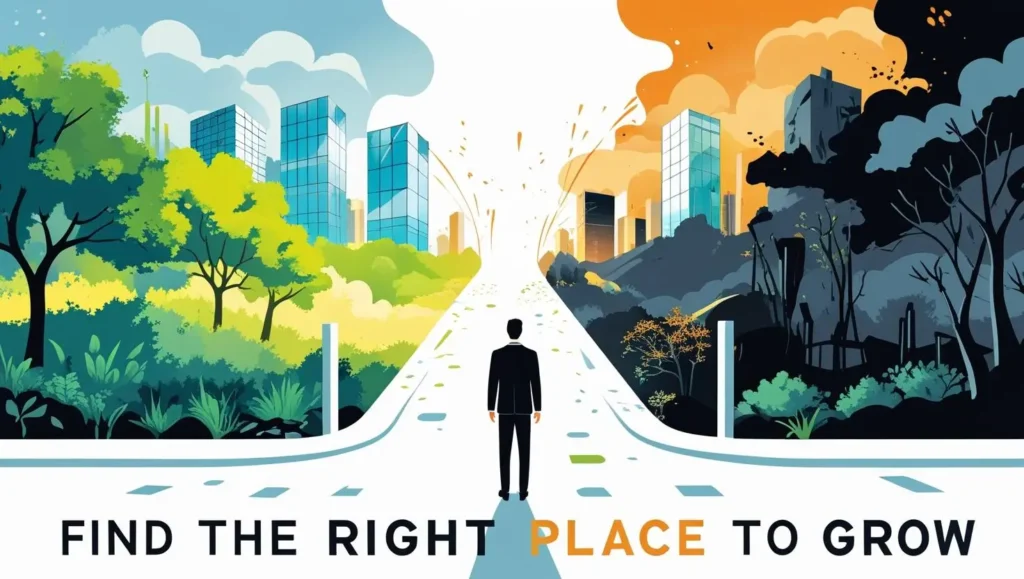
Setting the Real Focus
In today’s unpredictable professional world, many capable individuals work hard yet feel stuck. Not because they lack talent, but because they are in environments that do not recognize or nurture their potential.
Growth is not just about skills. It is about fit. Your abilities require the right environment to make an actual impact.
But there is a second layer: leadership. Leaders do not just manage people—they shape systems and cultures that either help people thrive or quietly hold them back.
This article brings both perspectives together:
- For individuals: How to find environments that align with your purpose and skills.
- For leaders: How to build workplace cultures where growth becomes exponential.
By the end, you will gain clarity on:
- How to assess if your current environment helps or limits your growth.
- What leadership systems silently shape workplace culture?
- Concrete steps both individuals and leaders can take to align purpose, people, and place.
Why Your Value Depends on the Right Place — A Story That Explains Everything
A father once handed his son an old watch that had been in their family for 200 years. Curious, the son asked how much it might be worth. The father suggested that he take it to a jewelry shop and find out.
At the jewelry shop, the son was offered $150 for the watch. Unsatisfied, he visited a pawn shop next. There, the same watch was valued at merely $10. Finally, the father advised his son to visit a museum and explore the prices of watches there. At the museum, experts scrutinized that watch and became settled entirely. They soon recognized that it was priceless and offered the boy $500,000 for it.
The son was stunned. They had the same watch, yet each place valued it differently. His father smiled and said, “The right Place will always recognize your true worth. Do not stay where you are not valued.”
This lesson applies directly to our professional lives. Your skills, character, and potential remain constant — yet if you are in an environment that does not recognize or nurture them, they remain unseen.
When you find the right fit:
- Your strengths amplify.
- Your ideas gain momentum.
- Growth feels natural rather than forced.
When the fit is wrong, even the most capable individuals experience quiet frustration. Energy fades. Motivation slips away. Potential stays locked inside, waiting for the right place to unlock it.
The real growth question is not just, “What skills do I have?” but also, “Am I in the right environment for those skills to create impact?”
Why Organizations and Individuals Fall Out of Sync: Misfit Syndrome
At the beginning of a new role, an employee often feels a surge of excitement—the promise of growth, learning, and making a meaningful contribution. You join a reputable company that is respected in its industry. But as days turn into weeks, something subtle begins to shift. Despite the organization’s image, you feel out of place. Your enthusiasm fades slowly. Your work feels mechanical rather than meaningful.
Why does this happen? The real value in any workplace does not come from a brand name or an impressive job title alone. It comes from alignment between people, culture, and purpose.
When that alignment is missing, what I call ‘The Misfit Syndrome’ takes hold. It is not always loud or obvious. Sometimes, it creeps in quietly:
- Trust between employees and leadership starts to fade.
- Engagement levels drop. Work feels disconnected from purpose.
- Growth stagnates — not because there is no opportunity, but because the environment does not enable it.
The Misfit Syndrome reveals itself through clear signs:
- Your role does not match your proper skills or strengths.
- Leadership behavior consistently clashes with your values.
- The broader workplace culture is lacking in fairness, trust, and basic dignity.
Recognizing this situation is not about assigning blame; it’s about understanding the underlying causes. It is about self-awareness. Every professional must pause at times and ask: “Am I staying in a place that quietly erodes my potential?”
Is it time to move towards an environment that truly values me and what I bring to the table?
Growth happens where both individual effort and organizational culture align. One without the other eventually leads to stagnation.
If you often find yourself navigating unclear leadership cultures, it is worth asking: What Kind of Leadership Systems Are You Reinforcing?
How to Find Your Purpose and the Right Environment: A Strategic Approach
Career growth is not a matter of luck. Neither is it about hoping to stumble into the proper organization. Career growth requires deliberate planning and a strategic approach. It is an intentional process that combines self-reflection, strategic research, and transparent decision-making. The professionals who grow consistently are not necessarily the most talented people. Often, those people are most intentional about where they invest their energy.
Here is how to approach it:
Clarify Your Core Values and Purpose
Start by asking yourself: Beyond salary or status, what kind of environment truly helps me thrive?
Write down:
- Your non-negotiable workplace values. Examples include fairness, innovation, and transparency.
- Leadership styles that support your growth—do you prefer structured guidance or autonomy?
- The type of work that gives you real meaning, not just what you are good at, but what energizes you.
For a deeper understanding of how a clear sense of purpose fuels real, lasting growth, explore The Power of Purpose: Unlocking Growth Through a Clear Why.
Assess Your Skills and Strengths with Honesty
Growth depends on clarity about what you bring to the table. Make two lists:
- Hard skills: Technical abilities like strategy, writing, and analytics.
- Soft skills: Relationship-driven abilities, including communication, empathy, and adaptability. Not all soft skills are equal in impact—some drive career growth far more than others. Explore the five most essential soft skills that truly move your career forward.
Often, others can see strengths you might overlook. Ask trusted colleagues or mentors for their perspective. Patterns usually emerge that point towards your natural zone of excellence.
Research Culture Beyond Branding
The website and social media pages of an organization can not tell the whole story. Real insights can be obtained from honest conversations. Do the following:
- Speak with current and former employees.
- Follow key leaders on platforms like LinkedIn to observe how they communicate and lead.
- During interviews, ask purposeful questions, such as: “How is feedback typically handled here?” or “What does recognition look like in this organization?”
Listen not just to the words but to the tone and consistency in their answers.
Network Intelligently, Not Randomly
Do not limit your search to job postings. Many of the best career moves happen through networks and informal conversations.
- Attend professional events, webinars, or industry meetups.
- Set up informational calls or coffee chats with people in roles or companies you admire.
- These connections often open doors that formal channels do not.
Trust Your Instincts — The Quiet Signal Matters
Sometimes, a role may look perfect on paper, but something feels off. Pay attention to that quiet discomfort.
- If things feel misaligned during interviews or in the first weeks of a new role, take it seriously.
- Early signals often reveal long-term patterns.
One often-overlooked growth lever is your peer circle. As HBR argues, true advancement often comes from “surrounding yourself with people who will push you”—those who challenge your thinking, stretch your perspective, and help you become better than you thought possible.
Grow Where You Are While Preparing for Better
Even if you are seeking a better environment, never stop growing in your current one.
- Take on new projects.
- Build new skills.
- Strengthen professional relationships.
Growth is never wasted, even if you eventually decide to move on.
While sharpening your skills and character is vital wherever you are, aligning them with the right environment can create a real impact. Discover how to develop skills, competence, and character for excellence.
The Leadership Equation — Building Cultures Where People Thrive
Self-awareness is essential for individuals, but leadership is what shapes the broader ecosystem. If leadership systems and workplace culture do not support people’s growth, even talented employees can find it very challenging to grow. Authentic leadership is not about control—it is about nurturing environments where people can thrive, contribute, and innovate consistently.
Here is what effective leaders focus on:
Prioritize Cultural Fit in Hiring
Skills by no means are not essential, but they are not enough to meet the goals. As a leader, you must look beyond qualifications and make sure that new hires possess attitudes and behavior that are aligned with the organization’s values and behavioral expectations. Such deliberate alignment reduces friction and strengthens team cohesion from the start.
Invest in People Development
Growth must be a continuous process, not an eventual occurrence in your organization. Leaders’ responsibility is to establish clear pathways for development, whether through structured training, mentorship programs, or learning platforms. When employees see a future within the organization, their commitment deepens.
Provide Transparent and Constructive Feedback
Feedback should not be a rare event tied only to formal reviews. Consistent, two-way feedback loops build trust. Leaders who encourage open dialogue—where employees can also share upward feedback—create an environment of respect and continuous improvement.
Recognize and Reward Merit Fairly
Recognition should be regular, visible, and merit-based. Favoritism, politics, or inconsistency erode morale. When recognition systems are transparent and tied to clear outcomes, both performance and trust improve.
Embody Your Values Through Action
Leadership is visible. What leaders model in their behavior becomes the default culture. If empathy, accountability, or innovation are core values, they must be demonstrated daily, not just written in a handbook.
Foster Psychological Safety
People perform best when they feel safe to speak, share ideas, and challenge norms without fear of negative consequences. This kind of safety does not happen automatically; it is a deliberate leadership choice reinforced through policies and everyday behavior.
When leadership behavior aligns with individual purpose, growth compounds, and it becomes a shared journey—one that benefits both the individual and the organization as a whole.
Much of psychological safety depends on transparent and open dialogue. Explore how mastering communication can become your most vital career skill.
Final Reflection — Aligning Careers and Cultures for Real Impact
Growth is not a one-sided phenomenon. It takes place where people’s purposes and organizations’ cultural values align well.
For individuals, this reflection matters: “Am I truly in the right place to unlock my best self?”
An equally important question exists for the leaders: “Am I creating and nurturing an environment where people can grow and contribute to the fullest?”
This is not about luxury: It is about maximizing sustainable value for both people and businesses. Teams perform at their best when individuals feel valued, empowered, and aligned with the organization’s mission.
That is the valid leadership equation: Purpose + People + place = Exponential Growth.
Conclusion: Are You Ready to Find Your Place?
Clarity matters whether you are striving to grow your career or leading an organization.
Do not settle for environments that quietly mute your potential. Seek out—or create—places where purpose, skills, and opportunity align. That is where real growth begins.
🧭 Looking to Align Your Career with a Deeper Sense of Purpose?
Discover how purpose shapes leadership and growth through Sarwar’s story → About Me.
Have a question, idea, or opportunity to collaborate? Reach out here → Contact Us.
Let us work together to build careers and organizations where clarity, values, and long-term impact move in the same direction.
Disclaimer: This article is based on personal experience and insights. It does not constitute financial, legal, or medical advice.





